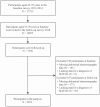Association of MAFLD With Diabetes, Chronic Kidney Disease, and Cardiovascular Disease: A 4.6-Year Cohort Study in China
- PMID: 34508601
- PMCID: PMC8684479
- DOI: 10.1210/clinem/dgab641
Association of MAFLD With Diabetes, Chronic Kidney Disease, and Cardiovascular Disease: A 4.6-Year Cohort Study in China
Abstract
Context: In 2020, the terminology of metabolic dysfunction-associated fatty liver disease (MAFLD) was proposed to replace nonalcoholic fatty liver disease (NAFLD).
Objectives: This work aimed to investigate the prevalence and incidence of MAFLD and evaluate its effects on incident extrahepatic diseases.
Methods: A total of 6873 individuals, with a 4.6-year follow-up, were included in this study. Associations of MAFLD and NAFLD with diabetes, chronic kidney disease (CKD), and cardiovascular disease (CVD) were examined using logistic regression and Cox proportional hazards models.
Results: The prevalence of NAFLD and MAFLD was 40.3% (95% CI, 39.2%-41.5%) and 46.7% (95% CI, 45.6%-47.9%), respectively. Additionally, 321 (4.7%) and 156 (2.3%) participants had MAFLD with excessive alcohol consumption and hepatitis B virus (HBV) infection. During the follow-up period, the incidence of NAFLD and MAFLD was 22.7% (95% CI, 21.3%-24.0%) and 27.0% (95% CI, 25.5%-28.4%). MAFLD was associated with higher risks of incident diabetes (risk ratio [RR] 2.08; 95% CI, 1.72-2.52), CKD (RR 1.64; 95% CI, 1.39-1.94), and CVD (hazard ratio 1.44; 95% CI, 1.15-1.81). Similar associations for NAFLD were observed. Furthermore, the MAFLD subgroups with excessive alcohol consumption (RR 2.49; 95% CI, 1.64-3.78) and HBV infection (RR 1.98; 95% CI, 1.11-3.52) were associated with higher risks of incident diabetes.
Conclusion: The change from NAFLD to MAFLD did not greatly affect the associations with diabetes, CKD, and CVD. MAFLD further identified those patients of metabolically fatty liver combined with excessive alcohol consumption and HBV infection, who had increased risks of incident diabetes compared with those of non-fatty liver.
Keywords: cardiovascular disease; chronic kidney disease; diabetes; metabolic dysfunction–associated fatty liver disease; nonalcoholic fatty liver disease.
© The Author(s) 2021. Published by Oxford University Press on behalf of the Endocrine Society.
Figures




Similar articles
-
Metabolic Dysfunction-associated Fatty Liver Disease and Mortality Among Chinese Adults: a Prospective Cohort Study.J Clin Endocrinol Metab. 2022 Jan 18;107(2):e745-e755. doi: 10.1210/clinem/dgab644. J Clin Endocrinol Metab. 2022. PMID: 34467980
-
Non-alcoholic fatty liver disease, metabolic goal achievement with incident cardiovascular disease and eGFR-based chronic kidney disease in patients with prediabetes and diabetes.Metabolism. 2021 Nov;124:154874. doi: 10.1016/j.metabol.2021.154874. Epub 2021 Sep 10. Metabolism. 2021. PMID: 34517014
-
Risk of cardiovascular disease in patients with fatty liver disease as defined from the metabolic dysfunction associated fatty liver disease or nonalcoholic fatty liver disease point of view: a retrospective nationwide claims database study in Japan.J Gastroenterol. 2021 Nov;56(11):1022-1032. doi: 10.1007/s00535-021-01828-6. Epub 2021 Oct 3. J Gastroenterol. 2021. PMID: 34601620 Free PMC article.
-
Clinical outcomes of MAFLD versus NAFLD: A meta-analysis of observational studies.Liver Int. 2024 Nov;44(11):2939-2949. doi: 10.1111/liv.16075. Epub 2024 Aug 19. Liver Int. 2024. PMID: 39157862
-
Nonalcoholic fatty liver disease or metabolic dysfunction-associated fatty liver disease diagnoses and cardiovascular diseases: From epidemiology to drug approaches.Eur J Clin Invest. 2021 Jul;51(7):e13519. doi: 10.1111/eci.13519. Epub 2021 Mar 2. Eur J Clin Invest. 2021. PMID: 33583033 Review.
Cited by
-
Association between micronutrients intake and metabolic-associated fatty liver disease: a cross-sectional study based on the National Health and Nutrition Examination Survey.J Nutr Sci. 2023 Nov 24;12:e117. doi: 10.1017/jns.2023.99. eCollection 2023. J Nutr Sci. 2023. PMID: 38033509 Free PMC article.
-
Non-linear associations between cardiovascular metabolic indices and metabolic-associated fatty liver disease: A cross-sectional study in the US population (2017-2020).Open Life Sci. 2024 Sep 10;19(1):20220947. doi: 10.1515/biol-2022-0947. eCollection 2024. Open Life Sci. 2024. PMID: 39290497 Free PMC article.
-
A Bidirectional Relationship Between Hyperuricemia and Metabolic Dysfunction-Associated Fatty Liver Disease.Front Endocrinol (Lausanne). 2022 Feb 16;13:821689. doi: 10.3389/fendo.2022.821689. eCollection 2022. Front Endocrinol (Lausanne). 2022. PMID: 35250880 Free PMC article.
-
Nonalcoholic fatty liver disease versus metabolic-associated fatty liver disease: Prevalence, outcomes and implications of a change in name.Clin Mol Hepatol. 2022 Oct;28(4):790-801. doi: 10.3350/cmh.2022.0070. Epub 2022 May 11. Clin Mol Hepatol. 2022. PMID: 35545437 Free PMC article. Review.
-
Shift in prevalence and systemic inflammation levels from NAFLD to MAFLD: a population-based cross-sectional study.Lipids Health Dis. 2023 Oct 28;22(1):185. doi: 10.1186/s12944-023-01947-4. Lipids Health Dis. 2023. PMID: 37898739 Free PMC article.
References
-
- Younossi ZM, Koenig AB, Abdelatif D, Fazel Y, Henry L, Wymer M. Global epidemiology of nonalcoholic fatty liver disease—meta-analytic assessment of prevalence, incidence, and outcomes. Hepatology. 2016;64(1):73-84. - PubMed
-
- Zhou F, Zhou J, Wang W, et al. . Unexpected rapid increase in the burden of NAFLD in China from 2008 to 2018: a systematic review and meta-analysis. Hepatology. 2019;70(4):1119-1133. - PubMed
-
- Choi HSJ, Brouwer WP, Zanjir WMR, et al. . Nonalcoholic steatohepatitis is associated with liver-related outcomes and all-cause mortality in chronic hepatitis B. Hepatology. 2020;71(2):539-548. - PubMed
-
- Eslam M, Newsome PN, Sarin SK, et al. . A new definition for metabolic dysfunction-associated fatty liver disease: an international expert consensus statement. J Hepatol. 2020;73(1):202-209. - PubMed
Publication types
MeSH terms
LinkOut - more resources
Full Text Sources
Medical

